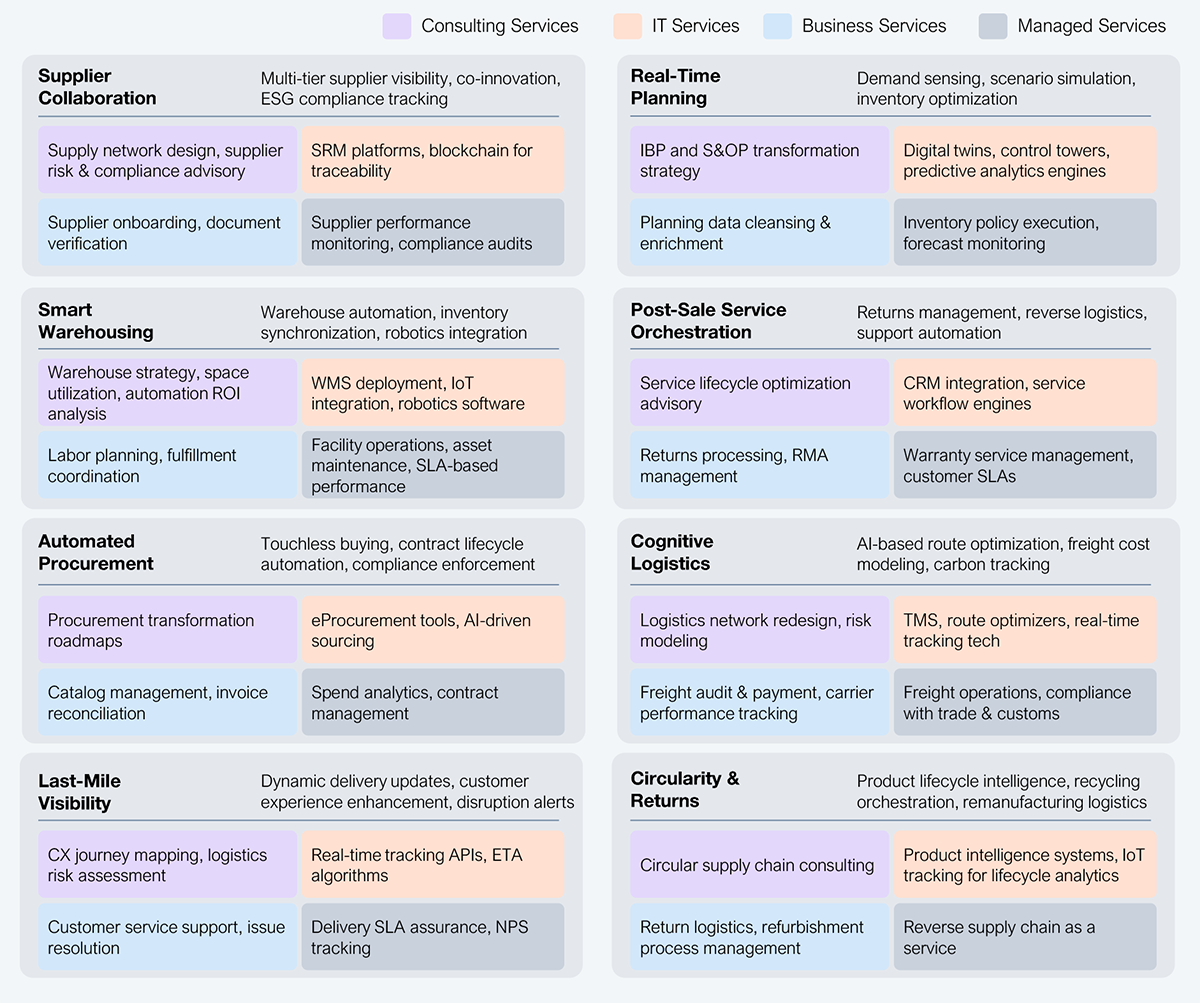Enterprises face relentless disruption from geopolitical upheavals, pandemics, tariffs, and climate shocks. Traditional, siloed approaches optimized solely for efficiency have become liabilities rather than strengths. Supply chain leaders must fundamentally redesign supply chains into interconnected ecosystems, characterized by interoperability, resilience, and adaptability. Those that do so now can expect to significantly outperform laggards, boosting operational effectiveness by at least 20–30%, according to recent industry benchmarks.
Addressing this crucial transformation, HFS Research has developed the Supply Chain Services Value Chain framework (see Exhibit 1), identifying eight interconnected strategic dimensions that enterprises must integrate comprehensively: real-time visibility and dynamic planning, circularity and returns, automated procurement, cognitive logistics, smart warehousing, post-sale service orchestration, collaborative supplier ecosystems, and last-mile visibility and customer experience enhancement. By embedding these capabilities, enterprises can move beyond addressing disruption to anticipating and strategically leveraging change, transforming vulnerabilities into competitive strengths.

Source: HFS Research, 2025
Collaborative ecosystems leveraging blockchain-enabled traceability, supplier relationship management (SRM) platforms, ESG compliance tracking, and proactive risk management are essential for operational transparency and supplier agility. Tesla exemplifies this strategic collaboration, achieving full traceability and proactive supplier management in its complex global operations. Furthermore, enterprises enhancing last-mile visibility—via dynamic delivery alerts, predictive ETA algorithms, proactive customer service automation, and logistics risk assessments—can consistently improve customer retention, satisfaction, and brand reputation during disruptions. Supply chain leaders must prioritize robust supplier ecosystems and advanced last-mile visibility technologies to maintain customer loyalty, regulatory compliance, and supply chain resilience amid uncertainty.
Real-time visibility combined with dynamic planning capabilities is no longer optional; they are strategic imperatives. Integrated business planning (IBP), sales and operations planning (S&OP), digital twins, predictive analytics, scenario simulation, and real-time inventory optimization capabilities significantly improve enterprise agility, reducing the response time to disruption by up to 40%. Amazon exemplifies such agility, leveraging digital twins and predictive analytics to dynamically reallocate inventory and logistics resources within hours, mitigating losses during critical disruptions such as pandemics or port closures. Enterprise leaders must prioritize immediate investment in advanced visibility and predictive planning platforms, enabling swift, proactive responses to emerging disruptions.
Warehouses must transition from passive storage facilities into strategic agility hubs using robotics, IoT-driven inventory synchronization, automation, and dynamic asset management. Smart warehousing typically improves inventory accuracy by 20–30% and labor efficiency significantly. Walmart’s investment in warehouse robotics and IoT integration enables exceptional responsiveness to fluctuating consumer demands. Extending beyond warehousing, post-sale orchestration integrating CRM, automated returns management, warranty services, and reverse logistics further amplifies customer retention, often lifting customer satisfaction metrics by 15–25%. Enterprises must actively invest in smart warehouse technologies and robust post-sale orchestration platforms to enhance both operational resilience and customer engagement proactively.
Circularity, integrating IoT-driven lifecycle analytics, reverse logistics, refurbishment, recycling orchestration, and remanufacturing, strengthens resilience, optimizes resource efficiency, and enhances customer loyalty. Enterprises adopting comprehensive circular practices have achieved 15–25% reductions in resource waste and increased consumer retention significantly. Patagonia demonstrates how embedded circular models offer both market differentiation and substantial operational flexibility. Supply chain leaders must implement comprehensive circular strategies to comply with rising regulatory pressures and consumer expectations, converting sustainability from compliance into competitive advantage.
Automation and cognitive technologies are transforming procurement and logistics from reactive operational functions into proactive strategic assets. AI-driven procurement platforms, eProcurement tools, contract lifecycle automation, and spend analytics enable enterprises to reduce sourcing cycle times by 30–50%. Cognitive logistics solutions, including AI-based route optimization, freight cost modeling, transportation management systems (TMS), and carbon footprint analytics, significantly boost logistics efficiency and reduce emissions. Unilever’s deployment of AI-powered procurement and logistics platforms demonstrates measurable success in proactive supplier management, cost containment, and compliance assurance. Enterprises must swiftly adopt AI-powered procurement and cognitive logistics solutions, reducing transactional inefficiencies and proactively managing supplier and logistics risks.
Enterprise leaders have had enough of reactive fixes and brittle supply chains. The path forward isn’t another patch—it’s a full structural rethink. Overlay your current supply chain model onto the HFS Supply Chain Services Value Chain. Identify the gaps and then rebuild it brick by brick—connecting every node across planning, procurement, logistics, warehousing, post-sale service, and supplier collaboration into one intelligent, resilient system.
Register now for immediate access of HFS' research, data and forward looking trends.
Get StartedIf you don't have an account, Register here |
Register now for immediate access of HFS' research, data and forward looking trends.
Get Started